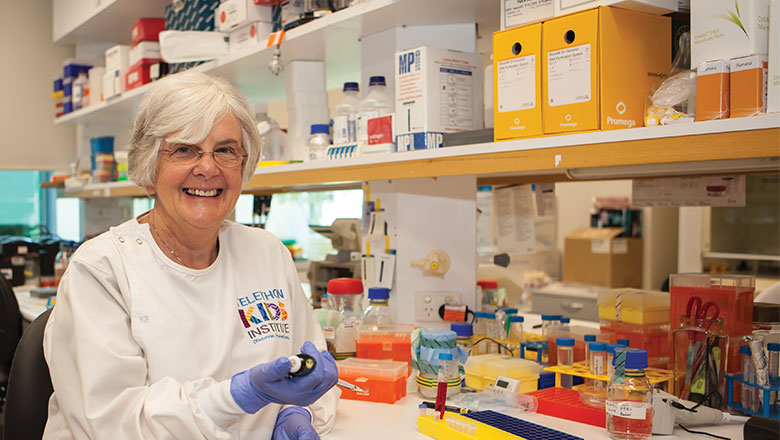Winning the support of a remote Aboriginal community paved the way for a pioneering genetics study.
With Type 2 diabetes identified as a big health challenge for Indigenous people, this world-first genome-wide association study in an Australian Aboriginal population examined genetic variations that influence body mass index (BMI) and Type 2 diabetes.
Genome-wide association studies are used to identify genes associated with complex diseases and provide insight into risk factors.
In this study of a Western Desert community, genetic variations that influence a high BMI and Type 2 diabetes were found to be similar to those in non-Aboriginal populations.
Professor Jenefer Blackwell, head of Genetics and Health at The Kids Research Institute Australia, said understanding the molecular basis to obesity and Type 2 diabetes in Aboriginal communities would assist in the development of better health management strategies.

Professor Jenefer Blackwell
She said it had been vital to overcome community concerns about the nature of genetic research and ensure culturally appropriate methods were employed.
“Overall, there was a huge mountain to climb initially to persuade Aboriginal researchers, Aboriginal communities, and Aboriginal ethics committees of the potential benefits of healthbased genetic research,” she said.
“The first step for us was to gain the confidence and support of Aboriginal researchers at The Kids Research Institute Australia. The second step was to establish a rapport with a specific Aboriginal community, to learn from them what they perceived as major health issues where genetics might play a role, and to explain to them what a study of genetic risk factors might tell us about disease pathways in their population.”
Working with the local Aboriginal Health Service and a remote-area school, they extracted DNA from saliva samples collected from about 400 people with Martu ancestry, including 89 with Type 2 diabetes.
“Studies in other communities worldwide had indicated that there was a heritable component of susceptibility to obesity and Type 2 diabetes but no one had looked at this using genomewide analysis,” Professor Blackwell said.
The top association was between BMI and NTRK2, a gene which belonged to a pathway of genes that had already been shown to be genetic risks factors in other populations.
“NTRK2 and the other genes in this pathway are providing signals in our brain that control our energy balance by regulating what we eat,” Professor Blackwell said.
“The more we understand about the pathogenesis of Type 2 diabetes, and how this relates to increasing obesity in the population, the better the advice that can be given. We aren’t necessarily at the stage of a magic bullet – a pill that will just cure everyone – but our work indicates that regulating our eating patterns will certainly help in prevention of Type 2 diabetes.”
Professor Blackwell said community participation in the project was essential. “We engaged with community to provide information and feedback in culturally-appropriate formats, including an art-based educational project for feedback of scientific results,” she said.
Using storytelling and painting, local children worked with an animator to create a YouTube video called The Story of the Goanna and the Gene, which relates a story about four animals – the kangaroo, emu, goanna and eagle - and the effects of fast food and sugary drinks on the body.
Professor Blackwell said study team members also complemented the clinical care received by the community by undertaking additional specialist clinics. “All the data from these specialist visits has been recorded in Aboriginal Health Service records for local clinical use, and contributed to clinical phenotypes for genetic analysis,” she said.
“The genetic information we collected has also been applied in relation to other extreme clinical conditions in this population, including severe otitis media (ear infections) in children, and endstage renal disease in adults.
“The data from our exome sequencing study has also provided the first Aboriginal reference panel for health-based research in Aboriginal populations. This data is already being used in the clinic as a reference panel to underpin diagnosis of rare diseases in Aboriginal Australians.”
What is BMI?
Body mass index is calculated by dividing your weight in kilograms by your height in metres squared. The result is used to determine whether you are in a healthy weight range for your height - between 18.5–25. This measure does, however, have its limitations, including not distinguishing between fat or muscle. For Aboriginals, a BMI over 22 is considered a risk factor for Type 2 diabetes.
